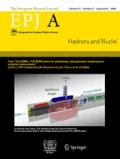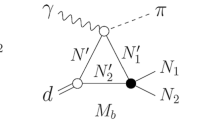Abstract
Recent data from the PIONS@MAX-lab Collaboration, measuring the total cross section of the incoherent pion photoproduction reaction, \(\gamma d\rightarrow \pi ^- pp\), near threshold, have been used to extract the \(E_{0+}\) multipole and total cross section of the reaction \(\gamma n\rightarrow \pi ^-p\), also near threshold. These are the first measurements of the reaction \(\gamma d\rightarrow \pi ^- pp\) in the threshold region. The value of \(E_{0+}\) is extracted through a fit to the deuteron data in a photoproduction model accounting for final-state interactions. The model takes an S-wave approximation for the elementary reaction \(\gamma n\rightarrow \pi ^-p\) with \(\hbox {E}_{0+} = \) const in the threshold region. The fit over all the 6 deuteron data points gives the value \(E_{0+} = -\,31.86\pm 0.8\) (in units \(10^{-3}/m_\pi \)). We explore the dependence of our results on the choice of data subsets included in the fit. The obtained values of \(E_{0+}\), for different subsets, have overlapping errors and agree with previous determinations.




Similar content being viewed by others
Data Availability Statement
This manuscript has associated data in a data repository. [Authors’ comment: see Ref. [14].]
References
D.G. Ireland, E. Pasyuk, I. Strakovsky, Photoproduction reactions and non-strange baryon spectroscopy. Prog. Part. Nucl. Phys. 111, 103752 (2020)
N.M. Kroll, M.A. Ruderman, A Theorem on photomeson production near threshold and the suppression of pairs in pseudoscalar meson theory. Phys. Rev. 93, 233 (1954)
G.F. Chew, M.L. Goldberger, F.E. Low, Y. Nambu, Application of dispersion relations to low-energy meson-nucleon scattering. Phys. Rev. 106, 1337 (1957)
A.I. Vainshtein, V.I. Zakharov, Low-energy theorems for photoproduction and electropion production at threshold. Nucl. Phys. B 36, 589 (1972)
F.A. Berends, A. Donnachie, D.L. Weaver, Photoproduction and electroproduction of pions. 1. Dispersion relation theory. Nucl. Phys. B 4, 1 (1967)
M. Hilt, B.C. Lehnhart, S. Scherer, L. Tiator, Pion photo- and electroproduction in relativistic baryon chiral perturbation theory and the chiral MAID interface. Phys. Rev. C 88, 055207 (2013)
V. Bernard, N. Kaiser, U.-G. Meißner, Threshold pion photoproduction in chiral perturbation theory. Nucl. Phys. B 383, 442–496 (1992)
V. Bernard, N. Kaiser, U.-G. Meißner, Chiral corrections to the Kroll–Ruderman theorem. Phys. Lett. B- 383, 116–120 (1996)
C.M.G. Lattes, H. Muirhead, G.P.S. Occhialini, C.F. Powell, Processes involving charged mesons. Nature 159, 694 (1947)
E.M. McMillan, J.M. Peterson, R.S. White, Production of mesons by X-rays. Science 110, 579 (1949)
J. Steinberger, W.K.H. Panofsky, J. Steller, Evidence for the production of neutral mesons by photons. Phys. Rev. 78, 802 (1950)
R.S. White, M.J. Jacobson, A.G. Schulz, The Production of charged photomesons from deuterium and hydrogen. I. Phys. Rev. 88, 836 (1952)
H.L. Anderson, E. Fermi, R. Martin, D.E. Nagle, Angular distribution of pions scattered by hydrogen. Phys. Rev. 91(1), 155 (1953)
W.J. Briscoe, M. Döring, H. Haberzettl, I.I. Strakovsky, R.L. Workman, Institute of Nuclear Studies of The George Washington University Database. http://www.gwdac.phys.gwu.edu/
W.J. Briscoe et al., A2 Collaboration at MAMI, Cross section for \(\gamma n \rightarrow \pi ^0 n\) measured at Mainz/A2. Phys. Rev. C 100(6), 065205 (2019)
D. Drechsel, S.S. Kamalov, L. Tiator, Unitary isobar model—MAID2007. Eur. Phys. J. A 34, 69 (2007)
B. Strandberg et al., PIONS\(@\)MAX-lab Collaboration, Near-threshold \(\pi ^-\) photoproduction on the deuteron. Phys. Rev. C 101(3), 035207 (2020)
J.-O. Adler et al., The upgraded photon tagging facility at the MAX IV Laboratory. Nucl. Instrum. Methods Phys. Res. Sect. A 715, 1 (2013)
M. Eriksson, The MAX-lab Story; from microtron to MAX IV. in Proceedings of the 5th International Particle Accelerator Conference (IPAC 2014), Dresden, Germany, June 2014. Joint Accelerator Conferences Website, JACoW, Geneva, Switzerland, 2014, Editors: Ch. Petit-Jean-Genaz et al., pp. 2852–2855
V.E. Tarasov, W.J. Briscoe, H. Gao, A.E. Kudryavtsev, I.I. Strakovsky, Extracting the photoproduction cross section off the neutron \(\gamma n\rightarrow \pi ^-p\) from deuteron data with FSI effects. Phys. Rev. C 84, 035203 (2011)
L.D. Landau, E.M. Lifshits, Quantum Mechanics: Non-relativistic Theory (Butterworth-Heinemann, Oxford, 1977)
M.I. Levchuk, A.Y. Loginov, A.A. Sidorov, V.N. Stibunov, M. Schumacher, Incoherent pion photoproduction on the deuteron in the first resonance region. Phys. Rev. C 74, 014004 (2006)
M. Döring, E. Oset, M.J. Vicente Vacas, S wave pion nucleon scattering length from \(\pi N\), pionic hydrogen and deuteron data. Phys. Rev. C 70, 045203 (2004)
V. Baru, C. Hanhart, M. Hoferichter, B. Kubis, A. Nogga, D. Phillips, Precision calculation of threshold \(\pi ^-d\) scattering, \(\pi N\) scattering lengths, and the GMO sum rule. Nucl. Phys. A 872, 69–116 (2011)
R. Machleidt, The high precision, charge dependent Bonn nucleon–nucleon potential (CD-Bonn). Phys. Rev. C 63, 024001 (2001)
D. Drechsel, L. Tiator, Threshold pion photoproduction on nucleons. J. Phys. G 18, 449 (1992)
O. Hanstein, D. Drechsel, L. Tiator, A Dispersion theoretical approach to the threshold amplitudes of pion photoproduction. Phys. Lett. B 399, 13–21 (1997)
V. Lensky, V. Baru, J. Haidenbauer, C. Hanhart, A.E. Kudryavtsev, U.-G. Meißner, Precision calculation of \(\gamma d\rightarrow \pi ^+nn\) within chiral perturbation theory. Eur. Phys. J. A 26, 107 (2005)
W. Chen et al., Amplitude analysis of \(\gamma n\rightarrow \pi ^- p\) data above 1 GeV. Phys. Rev. C 86, 015206 (2012)
W.J. Briscoe, A.E. Kudryavtsev, P. Pedroni, I.I. Strakovsky, V.E. Tarasov, R.L. Workman, Evaluation of the \(\gamma n\rightarrow \pi ^-p\) differential cross sections in the Delta-isobar region. Phys. Rev. C 86, 065207 (2012)
P.T. Mattione et al., CLAS Collaboration, Differential cross section measurements for \(\gamma n\rightarrow {\pi }^{-}p\) above the first nucleon resonance region. Phys. Rev. C 96(3), 035204 (2017)
D.H. White, R.M. Schectman, B.M. Chasan, Photoproduction of negative mesons in deuterium. Phys. Rev. 120(2), 614 (1960)
M. Salomon, D.F. Measday, J.M. Poutissou, B.C. Robertson, Radiative capture and charge exchange of negative pions on protons at 27.4-MeV and 39.3-MeV. Nucl. Phys. A 414, 493 (1984)
K. Liu, Radiative negative pion proton capture and the low energy theorem. Ph.D. thesis, University of Kentucky (1994) (unpublished)
Acknowledgements
This work was supported in part by the U.S. Department of Energy, Office of Science, Office of Nuclear Physics under Awards No. DE-SC0016583 and DE-SC0016582. The authors A. E. K. and V. E. T. acknowledge the support of the RFBR under Award no. 16-02-00767.
Author information
Authors and Affiliations
Corresponding author
Additional information
Communicated by Klaus Peters
Appendix: the reaction amplitude
Appendix: the reaction amplitude
The invariant amplitude \(M_{\gamma d}\) of the reaction \(\gamma d\rightarrow \pi ^- pp\) can be written as
Here: \(\varphi _{1,2}\) are the spinors of the final protons (\(\varphi ^+\varphi \equiv 1\)) and \(\varphi ^c\equiv \sigma _2\varphi ^*\); the subscripts a, b, c, d (in \(L_a\),.., \({\varvec{K}}_a\),..) correspond to the diagrams in Fig. 2; \(L^{(s)}_a\) and \({\varvec{K}}^{(s)}_a\) (\(L^{(d)}_a\) and \({\varvec{K}}^{(d)}_a\)) are the IA amplitudes with S-wave (D-wave) part of the DWF. The amplitudes \(L_a\),.. and \({\varvec{K}}_a\),.. are given below, where \({\varvec{e}}\) and \({\varvec{\epsilon }}\) are the photon and deuteron polarization three-vectors, respectively. Hereafter: \({\varvec{q}}\), \({\varvec{k}}\), \({\varvec{p}}_{1,2}\) stand for the three-momenta of the initial photon, final pion and final protons, respectively, in the laboratory frame.
(a) IA terms:
Here \({\varvec{n}}_{1,2}\) – the unit vectors; u(p) and w(p) are the S- and D-wave parts of the DWF. We use DWF [25], parametrized in the form
with normalization \(\int d{\varvec{p}}\,[u^2(p) + w^2(p)] = (2\pi )^3\) .
(b) \(\underline{pp\text {-FSI terms}}\):
Here \(f_{pp}(p)\) is the on-shell S-wave pp-scattering amplitude in the effective-range-approximation with Coulomb effects included [21]; \({\varvec{x}}\) is the relative three-momentum of the intermediate nucleons; f(x, p) is the form factor in the off-shell pp-scattering amplitude \(f^{off}_{pp}(x,p) = f(x,p)f_{pp}(p)\) with parameter \(\beta = 1.2\,\) fm, used earlier [20, 22]. The integral \(I_{pp}(p,\beta ,\Delta )\) is written out in Eqs. (A.9) and (A.10).
(c) \(\underline{\pi N\text {-FSI terms}}\):
Here: \(k_i\) are the relative momenta in the pion-proton pairs \(\pi ^-p_i\, (i = 1,2)\); \(a_{\pi ^- p}\) is the \(\pi ^-p\)-scattering amplitude in the scattering-length approximation (see the main text), \(m_\pi \) and m are defined after Eq. (2) in the main text. The integral \(I(k^2_{1,2}, \Delta _{1,2})\) is written out below in Eq. (A.9).
(d) 2-loop terms:
Here \(\sqrt{s_0} = 2m_p + m_\pi \); f(x, p) is given in Eq. (A.4); the denominator \((y^2 - b^2 - i0)\) of the pion propagator is obtained, neglecting the kinetic energies (static approximation) of the intermediate nucleons. The expression for \(K(p,b,\Delta )\) is given in Eqs. (A.11) and (A.12).
1.1 The square of the amplitude
The square of the amplitude Eq. (A.1) for unpolarized nucleons is \(|M_{\gamma d}|^2 = 2c^2\,(|L|^2 + |{\varvec{K}}|^2)\). Averaging it over the photon and deuteron polarization states, we write
Making use of Eqs. (A.2), (A.4), (A.5), and (A.6), we have
Then, we obtain
Here \({\varvec{n}}_{1t,2t}\) and \(n_{1z,2z}\) are, respectively, the transverse parts and z-components of the unit vectors \({\varvec{n}}_{1,2}\), defined in Eq. (A.2), with z-axis along the photon three-momentum \({\varvec{q}}\) in the laboratory frame.
1.2 The integrals
The integral \(I_{pp}(p,\beta ,\Delta )\) in Eq. (A.4) can be rewritten as
For the DWF, given in the form Eq. (A.3), we obtain
The integral \(K(p,b,\Delta )\) in Eq. (A.6) can be written as
For the DWF of the type Eq. (A.3), we obtain
Rights and permissions
About this article
Cite this article
Briscoe, W.J., Kudryavtsev, A.E., Strakovsky, I.I. et al. Threshold \(\pi ^-\) photoproduction on the neutron. Eur. Phys. J. A 56, 218 (2020). https://doi.org/10.1140/epja/s10050-020-00221-w
Received:
Accepted:
Published:
DOI: https://doi.org/10.1140/epja/s10050-020-00221-w



